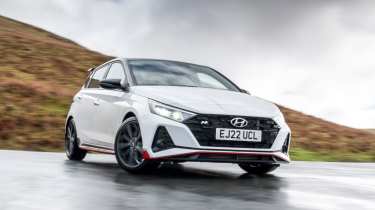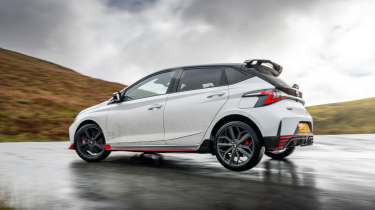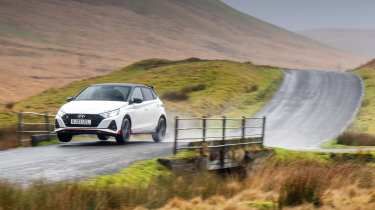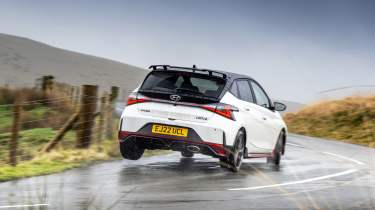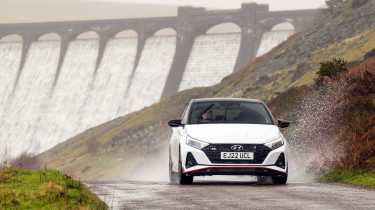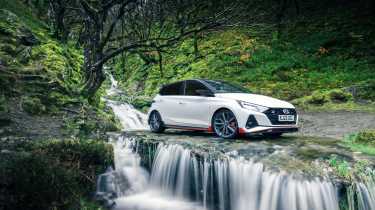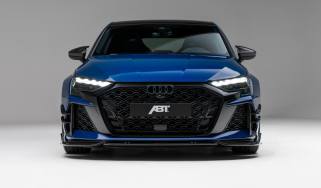The Hyundai i20 N is dead; we take it for one last drive
We take the now-discontinued Hyundai i20 N for a farewell drive. It truly is a modern hot hatch great
In a few short years, Hyundai N has accomplished a launch-control-worthy 0-60 in terms of brand awareness: thanks largely to the stellar i30 N and Hyundai i20 N hot hatches, N cars have become cult-hero modern classics within their own lifetime. And the halo effect has been transformative for Hyundai’s wider image, too. This most beige of brands was suddenly a maker of all-time-great affordable performance cars (and it’s been able to leverage that appeal with more profitable N Line trim levels for its mainstream models, too).
Now it’s starting again – not from square one, but by turning the page to a hefty new chapter. In the past few months, petrol-powered N cars have ended sales in Europe as the N department pivots to performance EVs, the first of which being the well-received Hyundai Ioniq 5 N.
To mark the changing of the guard, and take stock of Hyundai’s brief but bright stint as a master of the established hot hatch universe, we’re taking the i20 N on a well-earned adventure. And on these roads it’s hard to shake the feeling it’s been cut down in its prime. It feels as brilliant as ever, alive with an infectious sense of enthusiasm. Front-end grip is so keen it feels like the Pirellis’ compound is laced with mustard. The manual gearbox is joyously swift and slick. And like a few classic small hot hatches, it’s ever-eager to waggle its inside rear wheel in the air.
The limited-slip differential – standard-fit on UK-spec i20 Ns – hooks up nicely but there’s impressively little torque-steer. The i20 N’s tail can be quite mobile if you want it to be – particularly on track – but on the road, even in these conditions where the wipers are struggling to keep up with the rain, it’s largely stable and safe but always a giggle. Maybe it’s the psychological link with Hyundai’s vaguely i20-based WRC cars, but the i20 N feels like a rally car on these winding Welsh lanes, gravel rattling in the arches and one-corner, one-turn, no-correction steering inputs.
Mind you, it’s not quite one-corner, one-turn because you frequently find yourself fighting against bumps in the road: the i20 N’s MacPherson-front, torsion-beam-rear suspension (with stiffening measures versus a standard i20, to help the N change direction more eagerly) is a little on the unyielding side and it doesn’t breathe with the road like some hot hatches. Unlike its bigger, adaptively damped i30 N brother, it’s on passive dampers (the better to keep the i20 N affordable) but they feel like they get firmer as you ramp through the driving modes, as the steering becomes heavier and transmits more jolts through your arms.
Ah yes, the modes: an N car hallmark. As well as the usual Eco, Normal and Sport, there’s a further, more aggressive N Mode and an N Custom mode where you can pick ’n’ mix settings for steering weight, engine map, stability control level and exhaust rowdiness. All are easily toggled by quick-flick shortcut buttons on the steering wheel (you can also easily toggle automatic rev-matching at a single button-press) then you preset your favourite combo. Sound familiar? A little like modern-era BMW M cars, in fact.
No coincidence, of course. Shortly after the N subsection of the company had been created, Hyundai poached engineer and manager Albert Biermann from BMW, where he had spent 31 years, including in a pivotal role as chief engineer at BMW M division. It was Biermann who suggested that ‘N’, which had been chosen for the department’s name because it stood for Namyang, Hyundai’s R&D centre in Korea, should also stand for Nürburgring. ‘I suggested we combine it with Nürburgring because nobody [outside of the company] knows Namyang!’ he told me at the 2018 Nürburgring 24 Hour race (in which Hyundai was fielding a two-car i30 team in the TCR class – it would go on to win the WTCR World Touring Car Cup that year). ‘And we make a lot of big development decisions here, on the back-roads and on the track,’ he added. ‘We have tons of wind tunnel data, but final decisions are made here – in corners where you need a big heart, the car must feel planted.’ N engineers (try saying that in a hurry) have competed in the N24 race in development versions of the road cars, too, so the circuit really has played a key role in N cars’ creation.
The N section of Hyundai isn’t officially called N ‘division’ – one stop in the alphabet from M division – but it’s hard not to refer to it as such. In 2018, Thomas Schemera, another senior BMW exec, became a further key member of N management. At the launch of the i30 N Fastback – a swoopy three-box quasi-saloon variant – Schemera described the first time he drove the i30 N hatch on which it was based. Multiple configurable modes, raucous exhaust on start-up, torso-hugging seats, purposeful driving position… he recognised Biermann’s influence instantly.
The i30 N’s attributes set the template for the N cars that followed. Its spicy suspension set-up, Recaro-style seats, weighty power steering and gurgling, gargling exhaust voice are all there in the Hyundai i20 N too, and it uses the same software for its track-friendly stability control modes – Normal, Sport and Off. The N team were able to get involved in the base car’s development earlier than with the i30, however, so they could set their requirements before the regular i20’s design was frozen. They didn’t have to design a whole new front axle, as they did to transform the standard i30 into the i30 N, for example.
I’ve been lucky enough to run both i30 N and i20 N as long-term test cars in the past, and loved them both. The i30 N even more so than the i20 N: there’s something about the older, bigger car’s more muscular character, the extra performance of its brawny 2-litre engine over the 1.6-litre i20 and the sense that it’s a bit of a hot rod, a skunkworks-style development of a very ordinary base car into something special. But the i20 N does feel a more complete, cohesive car: you can tell N division got its mitts on the source material from the start.
It’s a superb modern performance car with character to match the great small hatches, but, equally impressively, the i20 N is great at being a normal car, too. It’s more refined than a small, lightweight car has any right to be (at 1190kg, its kerb weight is impressively scant by modern standards). It’s genuinely comfy on a long journey – far more so than a GR Yaris, or a Fiesta ST – and roomy as well. Reasonably frugal too, averaging mid-30s mpg figures, and often close to 40, compared with the thirstier i30 N’s mid-20s during my six months running both.
It’s positively luxurious in terms of standard equipment: heated seats and steering wheel; parking sensors and reversing camera; du jour digital dials and a more user-friendly touchscreen than most – although later models such as this one have frustrating touch-sensitive surfaces in place of buttons next to the screen, meaning more eyes-off-road time than with earlier cars. Big-car kit in a supermini space.
The graphics on the instrument screen are a bit puerile – rendered carbonfibre in Sport mode, and animated fire crackling around the tacho when you select N Mode – but this is a car with a sense of fun, and goodness knows that’s not a bad thing. A host of performance data can be displayed on the main screen and the instrument panel, from throttle opening and brake pressure to individual temperatures for coolant, oil and the engine itself. The latter in particular shows it’s been engineered by people who care about driving.
First time I drove an i30 N (and some earlier BMW M cars), I found the modes slightly gimmicky – sometimes it’s nice to enjoy the purity of a performance car without any modes at all – but they really do bring an extra dimension to the i20 N. You can save fuel and drive around quite unobtrusively in Normal or Eco mode, yet in Sport or N it feels a dramatically more eager machine. And having those presets – stability control all-off or part-off, rev-matching on or not – toggleable straight away from the wheel; there’s a lot to be said for that.
It’s not a perfect car, of course. Even in the lightest of its three weight settings, I find the power steering a little heavy for my tastes; its leaden feel actually makes the i20 N feel less nimble than it really is. And the engine feels a little leaden, too. Although the turbocharged 1.6 four has a 350-bar direct-injection pressure and a special ignition system for the i20 N, it’s a little lethargic in nature: a heavy flywheel means that revs take a moment to climb and likewise to die away. Drop out of the powerband and it can take a little while to get back into the turbocharged sweet spot, and sometimes upshifts are a little slurred, like a learner driver accidentally slipping the clutch, because the revs ‘hang’ a little. It doesn’t sound particularly inspiring either, even in the most vocal of the valved exhaust silencer’s three settings.
These are the smallest of nits to pick, though. This is a truly great car, and fully deserving of evo’s five-star rating. And all for a fiver under £25,000. There’s no hot hatch worth the name out there in that bracket now, more’s the pity.
And few small hot hatches full stop: no Fiesta ST, no 208 GTi. Only the more grown-up-feeling, less exuberant VW Polo GTI remains, and the upcoming new Mini JCW. If the i20 N is where the 205 GTI dynasty ends, it’s a fitting finale – but what a shame it’s seemingly at a close.
The marque's official statement for when the end of i30 N and Hyundai i20 N production for Europe was announced read: ‘Production of the ICE N models has ceased for the European market starting from February, in line with our commitment to offering a zero-tailpipe-emission line-up to our customers by 2035 and to operating 100 per cent carbon neutrally by 2045. Going forward in Europe, Hyundai is developing Hyundai N as a pioneer of high-performance EVs. Our customers will benefit from technological developments that will make EVs even more attractive in the future.’
The first such model, the Ioniq 5 N, is truly impressive. It combines front and rear electric motors for a 600bhp-plus total output, and in many ways makes a virtue of its powertrain; in other ways it deliberately mimics the behaviour of traditional combustion-engined performance cars, with the option to simulate the sound and response of a petrol engine and ‘eight-speed’ paddleshift gearbox.
The point is not to fool the driver but to assist them: driving quickly in a silent, gearshift-free EV can be a disorienting, even nauseous experience. A sweep of artificial revs – even hitting a false limiter, should you wait too long to change up in manual mode – builds acceleration in what feels like a more natural crescendo. On upshifts, the system temporarily backs off the power, and on downshifts it uses regenerative braking. You can downshift using ‘engine’ braking to tuck into corners just as you might in an i20N.
It’s even been designed to cope with long-ish stints on track (including multiple laps of the Nürburgring, something not necessarily possible in a Porsche Taycan, for example) without overheating. Not easy for an energy-hungry, 2.2-ton EV. (Yes, 2.2 tons.) With regenerative motor braking working together with the friction brakes, Hyundai says the brakes can actually last longer on track than an i30 N’s.
You can’t totally disguise its weight and bulk, and the Ioniq 5 N is a car that takes time to get to know properly. You need to delve into all the different modes and sub-modes (and if there were plenty of those in the i20 N, there are far, far more in the Ioniq 5 N) to get the best from it in different scenarios. But its bandwidth – from city driving to motorways to mountain passes to racetracks – is seriously impressive. We’re still at the beginning of understanding its capabilities, but N division has built a genuinely engaging all-electric driver’s car.
It doesn’t have the same immediate grin factor as the i20 N, though, and it’s a far from inexpensive car at £65,000. Compared with pricing in the mid-£20k bracket for the i20 N and low-30s for the i30 N, that’s quite a climb, for admittedly quite a car. And one can imagine, given the complexity of the Ioniq 5 N, that Hyundai may not be reaping an enormous profit from each one; like earlier N cars, it functions as a halo product, after all.
Hot hatches aren’t the land of milk and honey they once were for major manufacturers, as hatchback sales in general decrease and margins get tighter. The dearth of hot hatches on the market generally, and the high prices of those that remain – £50k-plus for the Civic Type R, £40k-plus for the latest GR Yaris and a £38k starting price for the new Mk8.5 VW Golf GTI – are evidence of that. And tightening emissions regs have played a part in hastening the petrol-powered N cars’ early exit from this market.
It’s well under a decade since the i30 N’s launch but it’s hard to remember a time when Hyundai N’s baby-blue signature colour wasn’t a part of the furniture in the hot hatch market. And less than half a decade since the i20 N’s introduction. This drive confirms the baby N car is a true great. Those Antipodean petrolheads in Perth knew that already. And coincidentally, on the evening I’m writing this, three ‘Hyundai N Yard Meets’ are being held concurrently at Caffeine & Machine’s venues. From Western Australia to the West Midlands, it’s truly remarkable that in a short space of time, from a standing start, an automotive sub-brand could become a cult folk favourite with global appeal. And that’s all down to the quality of the cars, and the Hyundai i20 N and i30 N in particular. If the next generation of electric-powered N cars are as impressive as the Ioniq 5 N, that groundswell of good feeling could well continue. But one can’t help but feel a little sad that N division has had to leave the old-school hot hatch party a little early.
